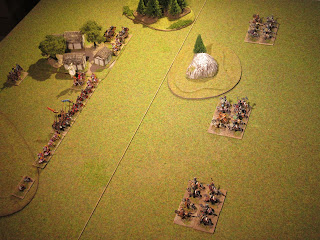One of the finest examples of a conflict between the Late Imperial army and that of the Patrician era is Constantine III bid for
the throne in 407 AD. Following the aftermath of the civil war and the barbarian crossing of the Rhine in 406 AD, Constantine III gathered his Britannic army and crossed the channel. He fought not only the migrating Germanic tribes also faced Roman forces sent
against him from Italia.
In this match series, the Late Imperial Roman army of Constantine III are seen with their white banner and the Patrician forces (purple banner) are noticeable by the addition of both mounted and infantry foederati.
Game 1
The battleground despite the wood and hamlet securing the left flank of each army was relatively open. The Patrician army (left
of photo) have positioned their legion in the centre flanked by foederati
troops and Hunnic allies are positioned further to their right. Constantine III positioned his legion opposite their counterpart with the auxilia and cavalry extending the battle line further. Both armies held a small reserve force withing bow shot of their front line troops.
Both centres advanced quickly forward as troops on
either flank squared off to meet their opposition.
Following the clash of battle lines, the Gothic
foederati on the left made brisk work by cutting down two units of auxilia but
this setback was meet with equal ferocity with the Britannic legion and
clibanarii destroying their opposition (2 – 2).
The battle now lost its cohesion as a breach in the line offered flanking opportunities. In this situation, the Britannic forces gained an advantage and crushed the Patrician army bringing the battle to a close. Score
5 – 2 for Late Imperial Roman.
Game 2
Now on the offensive, the army of Constantine III caught the
Patrician forces on an open plain with one wood offering meagre cover. Here, the Britannic forces made good use of the surrounding difficult hills
and hamlet to set up a defensive position while also secured their rear.
Seeing the Britannic forces were not willing to leave
their position, the Patrician army moved forward with their right flank leading
in echelon.
Both sides now seemed hesitant to engage and hesitantly moved forward (low pip scores for both). A feeble attack by the Patrician forces was easily countered by Constantine III.
In a desperate move to regain the momentum, the
Patrician general launched the Gothic foederati crushing a unit of auxilia for their effort. The Britannic legion held their ground and drove the Goths back on a supporting
column of foederati infantry. Having no further room to recoil, the Goths were
destroyed in place thus ending the battle. Score 4 – 1
for the Late Imperial Roman.
Game 3
Maintaining the offensive, Constantine III was able to repeat his good fortune and catch the
Patrician forces on an open plain. This time, the Patrician deployed its foederati troops as part of the main
battle line with the Hunnic allies positioned on each flank. The Britannic force rested its right flank on the difficult hill and all its infantry filling the open space between hill and the village. Heavy cavalry formed a second line and all the light horse were positioned further behind as an extra reserve.
The Patrician general seeing no threat on this left flank moved the Huns to a new position. Both battle lines now move quickly forward.
The armies met head on with both sides pushing and recoiling but neither side could make a breach in the other's line.
In time, gaps that did appear were quickly filled
by units held in reserve. Even Constantine III was seen in the thick of enemy troops.
Casualties were beginning to fall evenly on both sides
but the Britannic line was steadily seen moving back.
The battle was becoming desperate as neither side
would break leaving the small arena between hill and village littered with dead. (3 – 3).
The Gothic Feoderati had broken through the Britannic line but they were held to a standstill by the Illyriani LH. On the right flank, the Britannic forces were able to recovery the initiative and strike a decisive blow. This brought an end to a hard fought battle. Score 4 – 3 for the Late Imperial Roman.
II/82a Patrician Roman 408 – 493 AD Terrain
type: Arable, Aggression 0
1 x general (Cv or 3Kn), 1 x equites (Cv), 2 equites
(Cv or 3Kn or LH) or foederati (3Kn), 1 x legionnaire (4Bd), 2 x auxilia (4Ax),
3 x auxilia (4Ax) or foederati (4Wb), 2 x archers (Ps).


































































